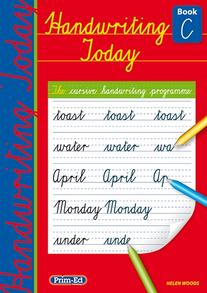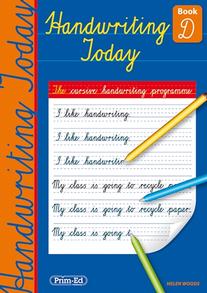-
0
Your cart is currently empty.
-
0
Your cart is currently empty.
English Handwriting Worksheets & Patterns
Are you looking for a way to help your pupils develop good handwriting skills? Our handwriting workbooks and patterns are specifically designed to help children learn how to write legibly and fluently. With clear instructions and plenty of practice, these workbooks will have your pupils writing with a neat, modern handwriting style.
Prim-Ed Publishing’s range of handwriting resources is ideal for use in the classroom or at home. Our workbooks range from pre-writing patterns for children who are just getting started with mark-making to our modern cursive programme suitable for pupils up to Year 6.
The importance of teaching handwriting at school and home
It may be true that many adults will spend more time typing on a computer keyboard or a phone than writing on paper these days. But good penmanship and learning to write cursive script neatly and legibly is still an essential skill for pupils to learn.
There are many benefits to handwriting practice:
- It can help improve fine motor skills (such as eye-hand coordination) and gross motor skills (such as posture).
- It can help children learn to organise their thoughts and ideas.
- It can improve spelling and composition skills.
- It can help children learn to focus and concentrate on a task.
- Children use a different part of their brain when they're writing by hand instead of when they're typing. This can help improve cognitive skills such as creativity and problem-solving ability, as well as helping them to read more fluently.
That is why it is crucial for parents and teachers to ensure that children develop pencil control and get plenty of handwriting practice.
Prim-Ed Publishing’s handwriting resources are designed to help children improve their handwriting skills in a fun and interesting way.
The whole-school approach to handwriting
At Prim-Ed Publishing, we believe that handwriting should be taught using a whole-school approach. This means that handwriting should be a part of the curriculum for every year level across the school, not just taught as a one-off unit of study.
Our handwriting patterns workbooks are designed to be used with pupils of all ages, from pre-school to Year 6. This will ensure that children's handwriting skills progress consistently as they move through their school years.
We also advise schools to prepare for a whole-school approach to learning handwriting skills by:
- Implementing a handwriting policy, including approved font, line sizing, time commitments, expectations and assessment strategies so that efforts are standardised across the school.
- Defining a progressive handwriting programme that is sequential and builds on skills mastered in earlier year levels.
- Introducing an early intervention programme for those struggling with fine motor skills (such as identifying and correcting poor pencil grip).
- Using an assessment system to track progress and identify pupils who may require extra support with their handwriting development.
- Encouraging parents and caregivers to practise handwriting at home with their children.
Our handwriting books and guides for teachers
If you're looking for a comprehensive guide to teaching handwriting skills, our handwriting resources for teachers are just what you need.
These guides provide teachers with everything they need to know about how to teach handwriting, from the basics of letter formation and spacing to more advanced cursive script.
Why use handwriting workbooks?
Our beginner workbooks start with simple tracing activities that the youngest children can manage. These exercises are not only fun for the children, but they also help them develop the fine motor skills and pencil control needed for handwriting.
As children progress through our programme, they will learn how to write neat cursive script while reinforcing their spelling skills at the same time.
Handwriting workbooks are a valuable tool for pupils. They're an easy and fun way for pupils to practise their handwriting at school or at home and can also be used as valuable assessment tools to track their progress.
Frequently asked questions
Is handwriting a part of the National Curriculum?
Yes, handwriting is part of the programmes of study for writing at key stages 1 and 2. The guidelines state that schools should actively teach pupils how to form letters correctly and encourage good handwriting habits from the beginning. From Years 3 and 4, pupils should be using joined handwriting.
At what age should children start learning joined-up (cursive) handwriting?
The Prim-Ed Publishing handwriting programme introduces joined handwriting from Year 2 / Primary 3 (six- and seven-year-olds). This is in line with the National Curriculum guidelines. However, each child progresses at their own pace, and individuals may be ready earlier or later than this suggestion.
How can teachers assess handwriting skills?
Our books include a range of assessments to help teachers determine the needs of their pupils. These assessments allow teachers to identify those who need extra support and those ready to move on to more advanced handwriting skills.
Do older primary school children still need to practise handwriting?
Yes! Practising handwriting is just as important for older primary school children. Our programme includes specialised workbooks to help pupils practise writing and develop their handwriting style, which is an essential skill in key stage 2 and beyond.





